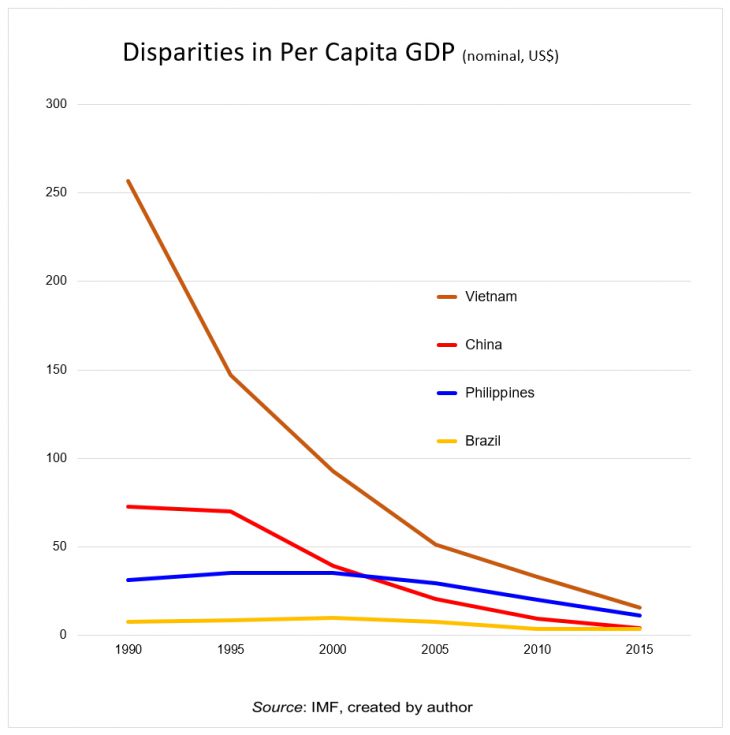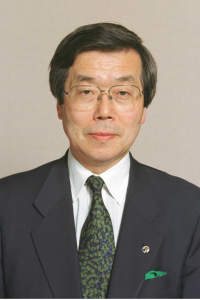Perspective on the Problems of Foreign Labor: Enacting Employment Policies That Encourage Long-Term Residence ― Improvements in Ability Development and Handling are Essential
< Key Points >
- 80% of foreign workers enter the country with different qualifications than a job title
- Due to the economic growth of developing countries, the appeal of working in Japan is on the decline
- An employment policy that requires foreign workers to return to their home countries without exception is not necessarily in Japan’s best interest

Tanno Kiyoto, Professor, Tokyo Metropolitan University
There have been frequent discussions regarding the acceptance of foreign workers both in governmental offices and among the Diet members. The “Choose the Future” Committee, organized by the Council on Economic and Fiscal Policy, has taken a leading role. In the minutes from the first meeting, although utilization of immigrants has become an issue for consideration in light of the declining birthrates in Japan, once discussion turns to acceptance of immigrants, the tone of the discussion declines, and the topic changes to “utilization of the skills of foreign workers” and “accepting foreign labor.”
In May of this year, the Liberal Democratic Party’s Special Mission Committee on Securing of Labor Force announced a “Standard Way of Thinking Regarding the Acceptance of Foreign Workers in Preparation for a ‘Cohabitation Era.’”
The current environment is as follows. Right now there is a need in Japan for additional labor from overseas, regardless of whether this is considered in terms of immigrants or foreign laborers. The reasons for this are clear. Japan’s workforce is aging, and the population is decreasing. As the economy is just starting to recover, the increase in the number of foreign people working in Japan is related to this problem.
As part of the terms of the Employment Measures Act currently in effect in Japan, businesses are required to report foreigner employment conditions. In 2015, there were a total of 908,000 foreign workers in Japan, an increase of approximately 190,000 since two years ago.
As a result of the revisions to the Immigration Control and Refugee Recognition Act in 1990, although it is not the same as receiving unskilled labor, the entry of individuals who fulfill the same social and economic functions was approved. These are the acceptance of long-term residents with Japanese heritage (accepting residence based on position or status) and trainees acquiring skills (accepting individuals who come to Japan to learn and become skilled laborers). The total number of these types of foreigners in Japan was 535,000 in 2015, an increase of 80,000 from two years prior.
In addition to this, another element of foreign labor that is becoming essential to Japan is study abroad students who are working part-time jobs. This is included in the activities outside of qualifications as part of the system for reporting employment to the Ministry of Health, Labour and Welfare. There were a total of 192,000 workers in this category in 2015, and this number was an increase from two years prior as well, rising by 70,000. Foreigners who didn’t originally come to Japan for the purpose of work make up 80% of the total foreign workers in Japan.
When discussing the acceptance of foreign workers, there is a tendency to focus on highly skilled personnel. The process of global headhunting back and forth for these kinds of workers is well-known. The introduction of a point system in Japan and the progression toward transparency in acceptance standards is also, to a large extent, a message to foreigners. However, the number of people who achieved high-level residency status in 2015 was just 2,332. The acceptance of the foreign workers this country wants to accept is clearly not going well.
Why is it that 80% of all foreigners working in Japan were not originally accepted into the country as workers? One reason for this is that even though the majority of the demand for foreign workers is in unskilled labor, the official policy doesn’t allow foreigners to enter the country as unskilled laborers. As a result, there are a number of foreigners who enter the country as study abroad students but then receive authorization to work at activities outside of those permitted by their residence status after arriving in Japan and enter the workforce, and this has become a set pattern.
Another reason is the demand for foreign workers entering based on their position or status. Although this is also related to the demand for unskilled labor, the benefit is that these kinds of foreigners can engage in work activities across multiple companies and industries. Because Japanese working visas are generally issued for specific work content, when companies are looking for foreign workers for jobs that are essentially in multiple fields, the pool is narrowed to only those who entered the country based on their position or status.
The Liberal Democratic Party committee has realized that the basic way of thinking on this point is a contradiction, and is stating that there will be a need to change the way the category “unskilled labor” is defined in the future.
On the other hand, will foreign workers continue to aim for jobs in Japan? In 2015, the population of foreign workers by country, starting from the largest, was as follows. China: 322,000, Vietnam: 110,000, the Philippines: 106,000, and Brazil: 96,000. At this point, let’s take a look at China and Vietnam as examples and examine the differential between these countries and Japan. Considering that these foreign workers are coming to this country for the purpose of working to send money home, the differential between Japan and these labor-exporting countries can be measured in comparison to the dollar.
In 1990, when Japan first accepted people with Japanese heritage and other groups into the country, the country’s gross domestic product (GDP) per capita was 72.5 times China’s and 257 times Vietnam’s. In 2000, this had changed to 39.1 times China’s GDP, and 92.8 times Vietnam’s GDP, in 2010, 9.6x and 33.2x, and as of 2015, the gap had shrunk to 4.1x and 15.6x (as shown in the figure).
The reason Japan’s demand for foreign labor is so biased toward unskilled labor is that this demand has a strong link to the need for temporary workers. However, the home countries of these foreign workers are experiencing rapid economic growth.
There is one suggestive case. Before the Lehman Brothers bankruptcy and the recession following it in 2008, there were 317,000 Brazilians living in Japan at the end of 2007. However, at the end of 2015, the number of residents had dropped to 173,000. After the Lehman Brothers bankruptcy, the Ministry of Health, Labour and Welfare implemented a support program to encourage foreign workers of Japanese descent who had lost their jobs to return to their home countries along with their families called the “Assistance Program for Returning Home.” This decrease in residents could be considered to be a result of that program. However, the number of Brazilian residents who returned to their home country through this program was only around 20,000. 120,000 of them returned of their own accord.
In 2008, the minimum wage in Brazil was 300 reais per month (at the exchange rate at the time, 17,000 yen). By 2015, this had increased to 788 reais (at that time, around 30,000 yen). The cost of living in Brazil is rising, and most of all, the prices for real estate that many Brazilians were saving to purchase while working in Japan have risen remarkably. As a result, those working in Japan need to earn more money than before, but in reality, working for a long enough time to earn that much is difficult.
These conditions are not a problem specific to Brazil. The rapid rise of the GDP per capita in China and Vietnam is also a result of the same conditions. The reason low wages in unskilled labor departments were able to draw in foreign workers in the past was because there was an overwhelming economic disparity between Japan and the labor-export countries. This disparity is shrinking year by year, and it is no longer true that foreign workers are willing to take on any job in this country. That era has passed, and we must all be aware of it.
Considering the future of the foreign labor problem in Japan with these current conditions in mind, more so than how we can accept new foreign workers, it’s important for us to change our ideas regarding how we should treat the foreigners currently working in Japan. At present, the term immigrants is avoided, and debate regarding acceptance of foreign workers is centered on short-term workers who will only stay about five years and will not settle in Japan or be able to start families here.
Individuals acquiring skills are one pattern of this, but the rotation policy that ensures foreign workers return to their home countries is not necessarily in Japan’s best interest. Large numbers of workers returning to developing countries with experiences they couldn’t have acquired at home are a source of labor supply for the businesses in these countries, and this policy could also possibly benefit overseas rivals of Japanese companies. This is one of the reasons why Japan’s status as the number one shipbuilder was overtaken by Korea and China in the blink of an eye.
On a basic level, human resources are both assets and resources for companies. Their nationality has no impact on this. Regardless of whether it can compensate for the declining population, if workers’ abilities have been developed, they should be developed further, and policies for doing this are needed for this both within companies and at the governmental level. Also, for foreign workers who can make a sufficient contribution to corporate management, it’s difficult to think of any way this would result in social costs if they are accepted as long-term residents in Japan.
Considering that the policy for utilization of foreign workers who won’t settle in this country is essentially the same as the survival strategy of low productivity companies and industries, foreigners who settle in this country should ideally be considered in relation to both employment policy and industrial policy.
Translated by The Japan Journal, Ltd. The article first appeared in the “Keizai kyoshitsu” column of The Nikkei newspaper on 23 June 2016 under the title, “Gaikoku-jin Rodosha no Shiten (3): “Choki-teiju Unagasu Koyo-seisaku wo ― Noryokukaihatsu/Shogukaizei ga Hissu” (Perspective on the Problems of Foreign Labor (Part 3 of 3) ― Enacting Employment Policies That Encourage Long-Term Residence – Improvements in Ability Development and Handling are Essential)” The Nikkei, 23 June 2016, p. 29. (Courtesy of the author)



